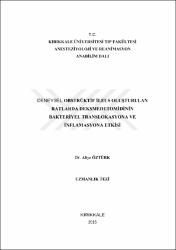| dc.contributor.advisor | Gençay, Işın | |
| dc.contributor.author | Öztürk, Aliye | |
| dc.date.accessioned | 2021-01-16T19:16:09Z | |
| dc.date.available | 2021-01-16T19:16:09Z | |
| dc.date.issued | 2015 | |
| dc.identifier.uri | | |
| dc.identifier.uri | https://hdl.handle.net/20.500.12587/17261 | |
| dc.description | YÖK Tez ID: 448752 | en_US |
| dc.description.abstract | Giriş/ Amaç: İleus ince ve/veya kalın barsağın, fonksiyonel veya mekanik obstrüksiyonuna bağlı oluşabilen parsiyel yada tam blokajıdır. Fonksiyonel veya mekanik ileus esnasındaki yaygın gastrointestinal dismotilite, intestinal dilatasyon, artmış lümen içi basınç barsak duvarında iskemiye yol açar. Her tip ileus abdominal sıvı sekestrasyonuna bağlı ciddi sistemik hipovolemi, intestinal bakteriyel çoğalmaya bağlı bakteriyel translokasyon, intestinal duvarda inflamasyonla beraber olan sitokinlerin artışı ve sistemik inflamatuar yanıt sendromunun gelişimine neden olur. Mekanik barsak obstrüksiyonlarında intestinal mukoza bakterilere karşı bariyer fonksiyonunu kaybederek, bakteriyel translokasyon oluşumuna zemin hazırlar. Deksmedetomidin selektif bir ?-2 adrenerjik reseptör agonistidir ve çoğunlukla yoğun bakımda sedasyon ve analjezik amaçlı kullanılır. Ayrıca sedatif, analjezik, hipotansif etkisinden dolayı perioperatif dönemde adjuvan ilaç olarak da tercih edilir. Bu çalışmanın amacı deksmedetomidinin, ileus tablosunda ortaya çıkan inflamatuar hadise, intestinal mukoza değişiklikleri ve bakteriyel translokasyon üzerine olan etkisinin incelenmesidir. Araç-yöntem: 24 Wistar-Albino rat rastgele 4 gruba (n=8); herhangi bir işlem uygulanmayan kontrol grubu, laparatomi sonrası intestinal ligasyon uygulanan sham grubu, intestinal ligasyon sonrası 5 µg/kg intraperitoneal deksmedetomidin uygulanan düşük doz grubu, intestinal ligasyon sonrası 30 µg/kg intraperitoneal deksmedetomidin uygulanan yüksek doz grubu olmak üzere ayrılmıştır. Cerrahi prosedürden 24 saat sonra kan kültüründe üreme, serum IL1ß, IL6, TNF?, kolon dokusu histopatolojik inceleme ile iltihabi hücre infiltrasyonu, hiperemi, ödem, mukoza kalınlıkları ve barsak MPO aktivitesi incelendi. Sonuç:Deksmedetomidinin düşük ve yüksek dozlarında plazma IL6 ve TNF? düzeylerinde sham grubu ile kıyaslandığında anlamlı olarak azalma görülmüştür. Sadece yüksek doz deksmedetomidin alan grupta IL-1ß düzeyi anlamlı olarak daha düşüktür. Barsak MPO aktivitesi sham grubu ile kıyaslandığında deksmedetomidin alan gruplarda anlamlı olarak baskılanmıştır. Histopatolojik değerlendirmede tam kat doku kalınlığı ilaç grubunda sham grubuna göre artmıştır. İnflamatuar değişiklikler, mukozal hasar, hiperemi ve ödem deksmedetomidin alan her iki grupta da azalmıştır. Sonuç olarak deksmedetomidinin antiinflamatuar etkisi ileus modeli oluşturulmuş ratlarda da doğrulanmıştır. | en_US |
| dc.description.abstract | Introduction/Aim: Ileus is the functional and mechanical obstruction of large and/or small intestine. During functional or mechanical obstruction, extensive gastointestinal dismotility, intestinal dilatation and increased intraluminal pressure causes ischemia at the intestinal wall. All forms of ileus causes fluid sequestration that leads to hypovolemia, bacterial translocation related to intestinal bacterial overgrowth, intestinal wall inflammation together with inceased proinflammatory cytokines and systemic inflammatory response syndrome. Mechanical obstruction of the bowel leads to impaired barrier function against bacteria and end up with bacterial translocation. Dexmedetomidine is a potent ?2 receptor agonist and commonly used as a sedation and analgesic drug in intensive care conditions. It can also be used in perioperative period as an adjuvant drug due to its sedative, analgesic and hypotensive effects. In this experimental study we aim to investigate the effects of dexmedetomidine on inflammation, intestinal mucosal changes and bacterial translocation that emergent with ileus scene. Material/Method: Twenty four Wistar-Albino rats were randomly seperated into 4 groups (n=8); control, sham group that intestinal ligation was performed after laparotomy, low dose dexmedetomidine group that 5 µg/kg dose intraperitoneal was administered after intestinal ligation and high dose dexmedetomidine group that 30 µg/kg dose intraperitoneal was administered after intestinal ligation. Twenty four hours after the surgical procedure, blood culture, blood plasma IL-1ß, IL-6, TNF ? levels, intestinal tissue histopathological examination and intestinal tissue MPO activity was evaluated. Result: Low and high doses of dexmedetomidine causes significant decrease at plasma IL-6, TNF ? levels when compared with the sham group. Only in high dose dexmedetomidine group, the decrease of plasma IL-1ß levels were significant. Intestinal tissue MPO activity was significantly lower in both of the dexmedetomidine groups compared with the sham group. Histopatological evaluation revealed that, complete tissue thickness was significantly higher in both of the dexmedetomidine groups. Besides, inflammatory changes, mucosal injury, hyperaemia and edema was significantly less in the dexmedetomidine groups than the sham group. As a result, the antiinflammatory effects of dexmedetomidine was validated in the ileus model constituted rats. | en_US |
| dc.language.iso | tur | en_US |
| dc.publisher | Kırıkkale Üniversitesi | en_US |
| dc.rights | info:eu-repo/semantics/openAccess | en_US |
| dc.subject | Anestezi ve Reanimasyon | en_US |
| dc.subject | Anesthesiology and Reanimation | en_US |
| dc.subject | | en_US |
| dc.subject | | en_US |
| dc.subject | | en_US |
| dc.subject | | en_US |
| dc.subject | | en_US |
| dc.subject | | en_US |
| dc.title | Deneysel obstrüktif ileus oluşturulan ratlarda deksmedetomidinin bakteriyel translokasyona ve inflamasyona etkisi | en_US |
| dc.title.alternative | The effects of dexmedetomidine on bacterial translocation and inflammation in the rat model of i·leus | en_US |
| dc.type | specialistThesis | en_US |
| dc.contributor.department | KKÜ, Tıp Fakültesi, Anesteziyoloji ve Reanimasyon Anabilim Dalı | en_US |
| dc.identifier.startpage | 1 | en_US |
| dc.identifier.endpage | 60 | en_US |
| dc.relation.publicationcategory | Tez | en_US |
















